The Hotel Kakslauttanen in Finland is in fact an Igloo Village, at which you can have your pick of 20 unique glass and snow igloos for your stay. They aren’t ice houses, but 31 well-maintained log cabins – built from a very special thermo glass that keeps them warmth and comfortable. Because of that, the temperature inside the Igloos is always a normal room temperature and the igloos inhabitants won’t feel any of the polar cold.

The Igloo Village Kakslauttanen boasts a World’s Largest Snow Restaurant. You can enjoy a drink at the Ice Bar, or visit the Ice Gallery for local art, or try the world’s largest smoke sauna if you get a chance, or throw the most memorable wedding or christening at the Ice Chapel.






The surrounding Finnish Lapland scenery is incredible – it’s a prime spot for marveling at the northern lights throughout the winter. When sleeping in the glass igloos you are able to for viewing the amazing natural phenomena – Aurora Borealis and the millions of stars in the sky. The experience is also unforgettable when there is a snowstorm


Wednesday, September 21, 2011
Igloo Hotel in Kakslauttanen, Finland
Wednesday, July 20, 2011
Afghanistan in the 1950's and 1960's
This is Afganistan of 50s and 60s. Lots of people would think that they will see pictures of wild, underdeveloped and medieval country with lif econditions worse than now. Oh well, think again.
Mohammad Qayoumi, president of California State University, East Bay, writes in Foreign Policy:
On a recent trip to Afghanistan, British Defense Secretary Liam Fox drew fire for calling it "a broken 13th-century country." The most common objection was not that he was wrong, but that he was overly blunt. He's hardly the first Westerner to label Afghanistan as medieval. Former Blackwater CEO Erik Prince recently described the country as inhabited by "barbarians" with "a 1200 A.D. mentality." Many assume that's all Afghanistan has ever been -- an ungovernable land where chaos is carved into the hills. Given the images people see on TV and the headlines written about Afghanistan over the past three decades of war, many conclude the country never made it out of the Middle Ages.
But that is not the Afghanistan I remember. A half-century ago, Afghan women pursued careers in medicine; men and women mingled casually at movie theaters and university campuses in Kabul; factories in the suburbs churned out textiles and other goods. There was a tradition of law and order, and a government capable of undertaking large national infrastructure projects, like building hydropower stations and roads, albeit with outside help. Ordinary people had a sense of hope, a belief that education could open opportunities for all, a conviction that a bright future lay ahead. All that has been destroyed by three decades of war, but it was real.
1. The physical campus of Kabul University, pictured here, does not look very different today. But the people do. In the 1950s and '60s, students wore Western-style clothing; young men and women interacted relatively freely. (MOHAMMAD QAYOUMI)

2. Today, women cover their heads and much of their bodies, even in Kabul. A half-century later, men and women inhabit much more separate worlds. (MOHAMMAD QAYOUMI)
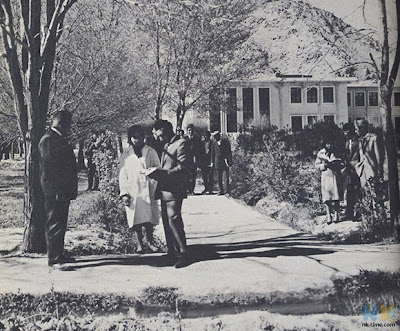
3. In the 1950s and '60s, women were able to pursue professional careers in fields such as medicine. Today, schools that educate women are a target for violence, even more so than five or six years ago. (MOHAMMAD QAYOUMI)

4. When I was growing up, education was valued and viewed as the great equalizer. If you went to school and achieved good grades, you'd have the chance to enter college, maybe study abroad, be part of the middle class, and enjoy a comfortable lifestyle. Education was a hallowed value. Today, I think people have become far more cynical. They do not see the link between education and a better life; they see instead that those who have accumulated wealth and power have not done so through legitimate means. (MOHAMMAD QAYOUMI)

5. This infant ward in a Kabul hospital in the 1960s contrasts sharply with one I visited in 2004 in Mazar-e-Sharif. There I found two babies born prematurely sharing the same incubator. That hospital, like many in Afghanistan today, did not have enough equipment. (MOHAMMAD QAYOUMI)

6.In the 1960s, about half of Afghanistan's people had access to some level of medical care; now a much smaller percentage do. Today's hospitals are crowded, the facilities limited; nearly one in four babies born in Afghanistan today does not reach its fifth birthday. (MOHAMMAD QAYOUMI)
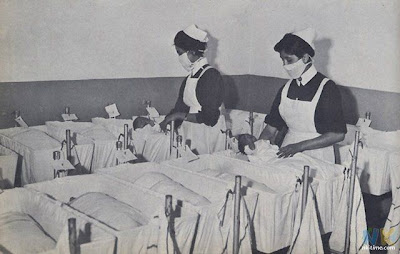
7. Above is a vaccine research center attached to a Kabul hospital in the 1960s. Today, medical care across the country is limited by several factors, including lack of electricity. Less than 20 percent of Afghans have access to electricity; many homes are lit by kerosene lamps, with only fans running to combat the heat. (MOHAMMAD QAYOUMI)

8. The central government of Afghanistan once oversaw various rural development programs, including one, pictured here, that sent nurses in jeeps to remote villages to inoculate residents from such diseases as cholera. Now, security concerns alone make such an effort nearly impossible. Government nurses, as well as U.N. and NGO medical workers, are regular targets for insurgent groups that merely want to create disorder and terror in society. (MOHAMMAD QAYOUMI)

9.Afghanistan once had Boy Scouts and Girl Scouts. In the 1950s and '60s, such programs were very similar to their counterparts in the United States, with students in elementary and middle schools learning about nature trails, camping, and public safety. But scouting troops disappeared entirely after the Soviet invasions in the late 1970s. (MOHAMMAD QAYOUMI)

10. This movie theater was located near where I once lived, and we could even see Hollywood movies there. (MOHAMMAD QAYOUMI)

11. A playground a few hundred yards away from the theater, where mothers used to take their children to play. Now, only men loiter in the city parks; it is unsafe to bring children outside. (MOHAMMAD QAYOUMI)

12. Light and medium industry, like this metal shop in the Kabul suburbs, once held great promise for Afghanistan's economy. But today, how could you run such an operation without ample electricity? Now there are only small shops, people who work at home -- no major industrial centers. Currently, Afghanistan's chief export is opium. (MOHAMMAD QAYOUMI)

13. With German assistance, Afghanistan built its first large hydropower station, pictured here, in the early 1950s. At the time, it was state of the art. It is still in operation, but unfortunately, in the last eight years, Afghanistan's government has not been able to build a single large power plant of any kind. The only sizable accomplishment has been the expansion of a transport line to Uzbekistan so that power can be imported from the north. (MOHAMMAD QAYOUMI)

14. Afghanistan did have medium and light industry, such as the textile factory pictured here. There was a sense then that Afghanistan had a bright future -- its economy was growing, its industry on par with other countries in the region. Back then, most of the cotton processed in a plant like this was grown locally. But three decades of war have destroyed industry and the supply chain. (MOHAMMAD QAYOUMI)
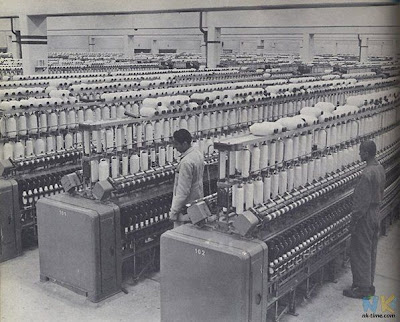
15. Compared with the 1950s and '60s, fewer women work outside the home, and their outfits are much more conservative than what you see here. (MOHAMMAD QAYOUMI)
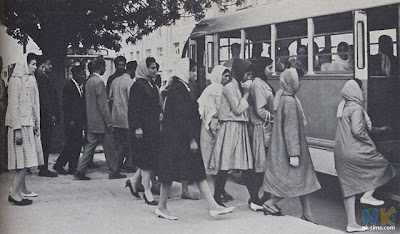
16. If you flipped through the radio dial in the 1960s, you would hear broadcasts of world news, local news, music programs, funny skits, political discourse, maybe an art program, a children's show. Radio Kabul, a state-run station whose old offices are pictured here, was launched in the 1930s. (MOHAMMAD QAYOUMI)

17. Modern Afghanistan actually has a greater number of private radio stations, as well as broadcast and satellite television shows. This is one bright spot. But access to radio and TV depends on electricity, and so in a practical sense, the audience is therefore limited. Only the most well-to-do families have private generators to ensure uninterrupted electricity to power electrical devices. (MOHAMMAD QAYOUMI)
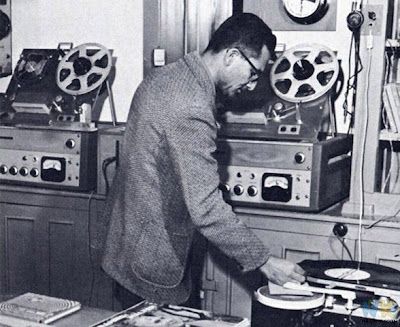
18. During the annual commemoration of Afghanistan's independence, Kabul was lit up at night in late August and early September for nine evenings in the early 1960s. Now the city is dark. Even driving at night gives an eerie feeling. There are hardly any lights on; the streets are desolate, and there is no night life. (MOHAMMAD QAYOUMI)

19. Clothing boutiques like these were a familiar feature in Kabul. (MOHAMMAD QAYOUMI)

20. So, too, were record stores, bringing the rhythm and energy of the Western world to Kabul teenagers. (MOHAMMAD QAYOUMI)

21. Today, furniture stores like this one are a rarity. Most furniture is manufactured outside Afghanistan, and only a small percentage of Afghans now have even simple furniture like this in their homes. (MOHAMMAD QAYOUMI)

22. Today it is only the fruit bazaars that still look the same. (MOHAMMAD QAYOUMI)

23. The education level of Afghanistan's cabinet today is far less than it was 50 years ago, when this photo was taken. Back then, most high-ranking government officials would have had master's or doctoral degrees. Western dress was the norm. These days, government meetings in Kabul are conducted among men, many with long beards, big turbans, and traditional garb. (MOHAMMAD QAYOUMI)

24. Afghanistan's once strong and functional defensive forces are today only a memory. After the Soviets left, Pakistan was instrumental in destroying the country's armed services. Since the 1990s civil war, the subsequent Taliban takeover, and the U.S.-led intervention, domestic security forces have proved extremely difficult to build, even as security remains a top concern. (MOHAMMAD QAYOUMI)

Source: foreignpolicy
Posted by Fresh Pics at 8:06 PM
Labels: Community and Lifestyle, Cool Pics, History, Travel
Tuesday, May 31, 2011
Top 10 Beaches in USA
Top 10 the best beaches in America, which was compiled by an expert Dr. Stephen P. Leatherman. “Dr. Beach” as it is called Stephen, is the head of the Laboratory for Coastal Research at the National University of Florida.
Siesta Beach, Sarasota, Florida

Beach Siesta, Sarasota County, Florida, famous for fine white sand and warm water, often ranks last in the annual ranking of the best beaches in America, in the same year it was the first time tops the list.
Coronado Beach in San Diego, California

Located about a mile from San Diego lies one of its best treasures. Coronado Beach is a great destination for the whole family. Your little ones can look for shells while the older kids will love body boarding in the gentle waves.
Kahanamoku Beach, Waikiki, Oahu, Hawaii

Almost everyone has heard of Waikiki Beach in Hawaii, which is surely one of the world's most beaches, with a location just steps from Honolulu's busy streets. Waikiki is actually a two-mile stretch with nine individually named beaches. Kahanamoku Beach is at the north end, near the Hilton Hawaiian Village Beach Resort.
Main Beach, East Hampton, NY

Main Beach has white sand, dunes, surf, lifeguards during summer, and spectacular fireworks on Labor Day weekend.
Cape Hatteras, North Carolina

Surfer love this beach on the coast of North Carolina.
National Park on the island of St. George, FL

In summer air temperature is 50-60 'Fahrenheit, it is cool enough to swim and sunbathe. Attracts fans for secluded relaxation. This place is also called "Forgotten Coast", because the majority of tourists still prefer the warmer coast and sent on vacation to the southern beaches of Florida.
Beachwalker Park, South Carolina

Located on Kiawah Island, Beachwalker Park offers 11 miles of unspoiled beach on one of the country's most beautiful barrier islands. Located between the Bohicket River and the ocean, the park features a wide boardwalk that weaves through live oaks, pines, palmettos, and yucca plants.
Coast Guard Beach, Massachusetts

The beach stretches for miles, has cliffs, dunes, good swimming in summer, body-surfing and boogie-boarding.
Gulf of Waimanalo, Oahu, Hawaii

Long white beach of the Gulf Waimanalo on displaying the Oahu, Hawaii, attracts thousands of tourists.
National Park on the Gulf of Florida

This beach will satisfy the demands of even the most demanding traveler: clean and clear water, gentle surf and white, fine sand.
Thursday, April 14, 2011
The Great Mosque of Djenné - The Largest Mud Brick Building in the World
The Great Mosque of Djenné is the largest mud brick building in the world. The mosque is located in the city of Djenné in Mali on the flood plain of the Bani River. It is one of the most famous landmarks in Africa. Along with the 'Old Towns of Djenné' it was dubbed a World Heritage Site by UNESCO in 1988.
The date of construction of the first mosque in Djenné is unknown but dates as early as 1200 and as late as 1330 have been suggested.
The walls of the Great Mosque are made of sun-baked mud bricks called 'ferey', a mud based mortar, and are coated with a mud plaster which gives the building its smooth, sculpted look. The walls are between 16 in and 24 in (0.4 to 0.6 m) thick. The thickness varies depending on the wall's height: taller sections were built thicker because the base has to be wide enough to support the weight. Bundles of deleb palm wood were included in the building to reduce cracking caused by frequent drastic changes in humidity and temperature and to serve as readymade scaffolding for annual repairs.
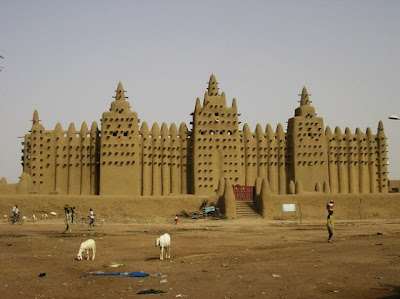
The walls insulate the building from heat during the day and by nightfall have absorbed enough heat to keep the mosque warm through the night. Gutters, made of ceramic pipes, extend from the roofline and direct water drainage from the roof away from the walls. Half of the mosque is covered by a roof and the other half is an open air prayer hall or courtyard. The roof of the mosque is supported by ninety wooden pillars that span the interior prayer hall. Vents in the roof are topped with removable ceramic caps, which when removed allow hot air to rise out of the building and so ventilate the interior.
The Great Mosque was constructed on a raised platform with a surface area of 5625 m² (62,500 ft²), which has so far protected the mosque from even the most severe floods. (Wikipedia).
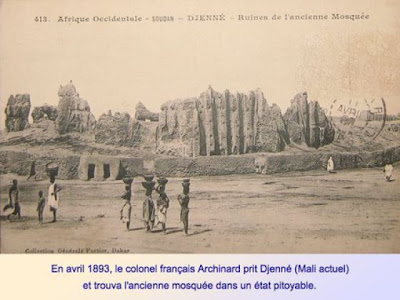
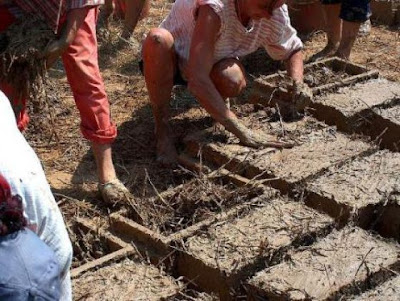
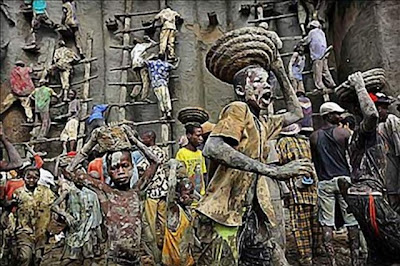
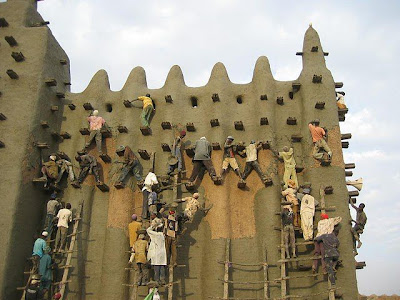
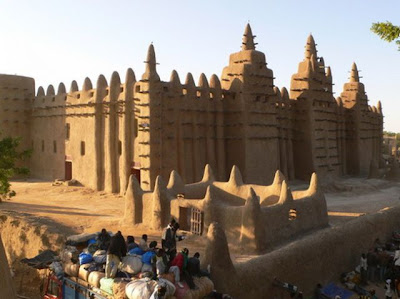



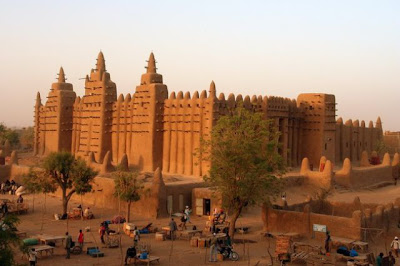
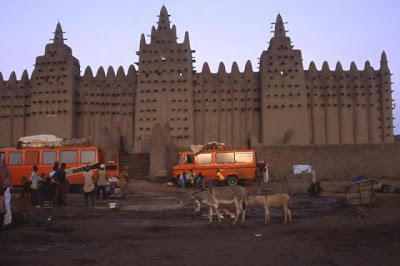
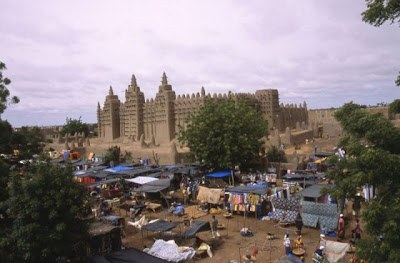
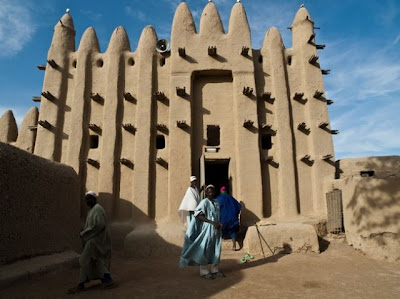
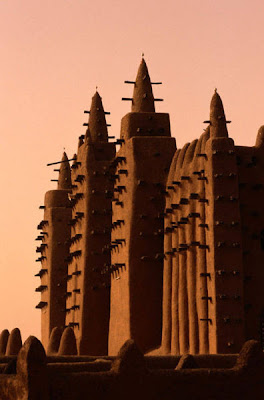
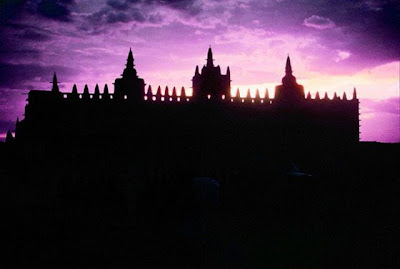

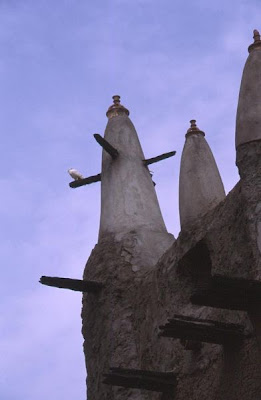
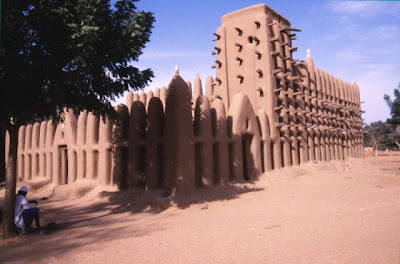

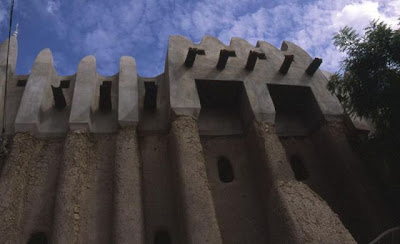

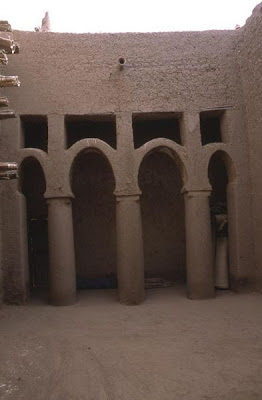
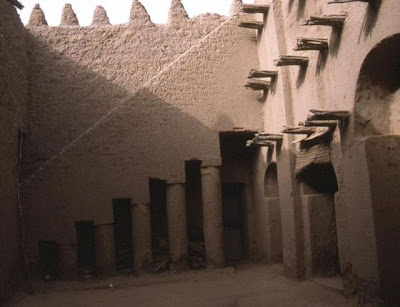


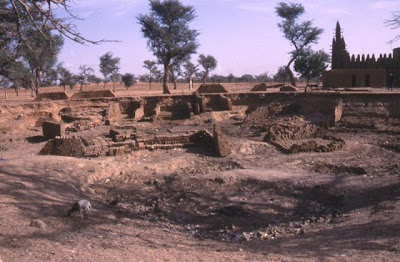
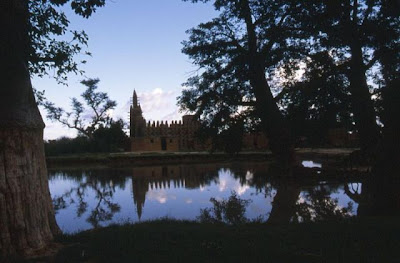

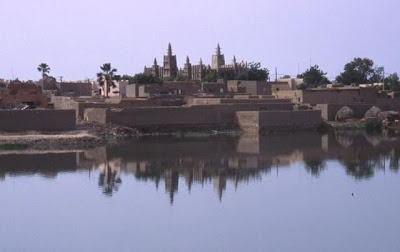

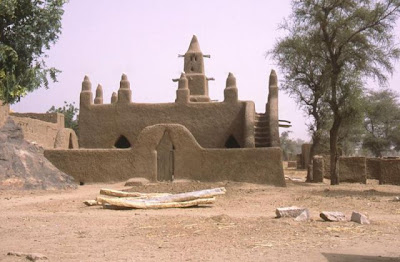



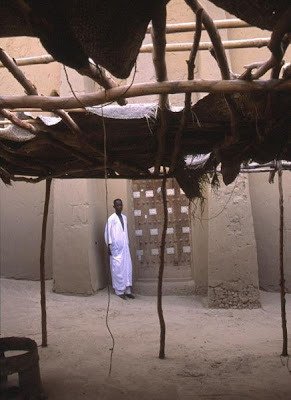
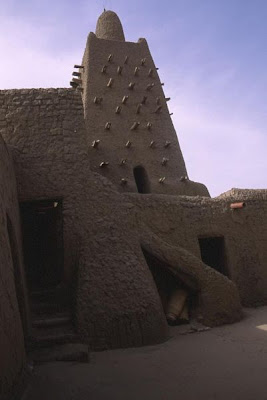
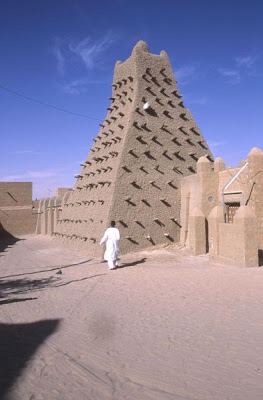

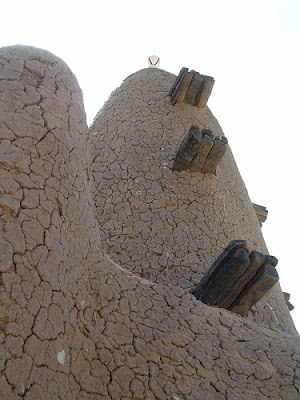
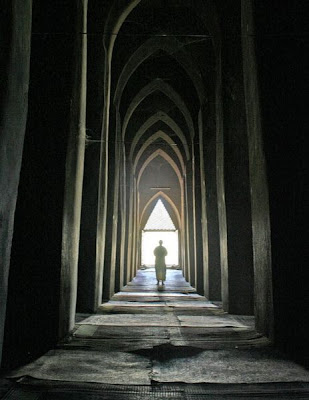

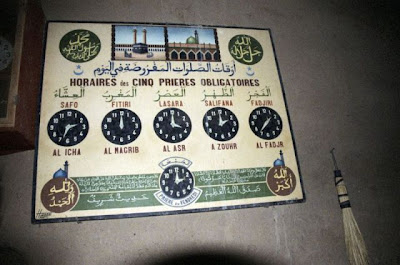
Source: clarepawley
Posted by Fresh Pics at 7:41 PM
Labels: Buildings and Architecture, Creative, Design, Feats and Records, History, Travel

